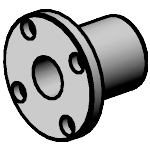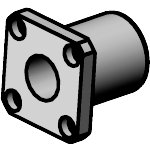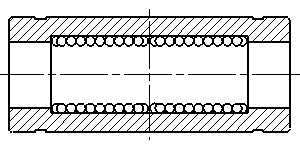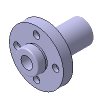(!)NOTE : Windows 7 users won’t be able to use some latest features of eCatalog/WOS since Microsoft is ending support for Windows 7 on 14 Jan, 2020. Please upgrade your system for uninterrupted services.
- Scheduled Maintenance Notice: This site will be unavailable due to scheduled maintenance from 6:30 23/2 to 4:30 (IST) 24/2/2025. We apologize for the inconvenience.
- Notice of End of Sales for Economy Series Pneumatic Equipment Category. More information.
Linear Bushings(Characteristics/Applications:Low Dust Generation)
Linear bushings, also known as slide bushings or linear ball bearings, provide vital functionality across various industries. Their use in machinery allows infinite linear motion, a feature leveraged in sectors from transportation and semiconductors to medical equipment and 3D printing.Industrial-grade linear bushing s
Linear bushings, also known as slide bushings or linear ball bearings, provide vital functionality across various industries. Their use in machinery allows infinite linear motion, a feature leveraged in sectors from transportation and semiconductors to medical equipment and 3D printing.Industrial-grade linear bushing solutions are carefully designed to meet the rigorous demands of heavy machinery. These high-quality components deliver low friction, high accuracy, and seamless linear motion, proving their efficiency and durability. For small-scale projects, affordable linear bushing options are readily available, offering superior performance without compromising on quality.Heavy-duty machinery can benefit from durable linear bushings, specifically designed to resist wear and tear, ensuring consistent performance over time. Materials used for linear bushings include steel, brass, and plastic compounds, each with distinct advantages. Steel bushings offer high strength and durability, while plastic variants provide corrosion resistance and reduced friction.The types of linear bushings range from simple linear ball bearings to complex designs, tailored to fit specific application requirements. These bushings provide numerous benefits, including smooth, precise motion, high load capacity, superior durability, a wide range of motion, and ease of maintenance.Proper installation of linear bushings is key to optimal performance and increased longevity. This seemingly simple process demands precision and attention to detail to ensure correct alignment, preventing uneven wear and enhancing overall performance.
|
Type
|
|
|---|---|
Brand |
|
| CAD |
|
| Days to Ship |
|
2 items
- Sort By
-
You can add up to 6 items per a category to the compare list.
![[Clean & Pack]Stoppers for Linear Bushings](//content.misumi-ec.com/image/upload/f_auto,q_auto,t_product_view_b/v1/p/jp/product/series/110310716309/110310716309_001_20230911105917.jpg?$product_view_b$)
[Clean & Pack]Stoppers for Linear Bushings
MISUMI
Three types of cleaning methods are available: degreasing, precision cleaning, and electrolytic polishing + precision cleaning. They can be ordered from one piece with the standard part number.
This eliminates the need for customer cleaning or outsourced cleaning, reducing the amount of time and effort required.■ Part Number for Clean & Pack Products· Degreasing (Anti-rust single packing) : Part Number SL-□□ · Precision cleaning (Degassing double packing) : Part Number SH-□□ · Electrolytic polishing + precision cleaning (Degassing double packing) : Part Number SHD-□□ Product Part Number Cleaning Method Packaging Type Effects Compared to Uncleaned Product Environment (Standard) Process SL-□□ Degreasing Anti-rust packing Oil removal General environment Regular assembly process Post battery assembly process SH-□□ Precision cleaning Degassing double packing Oil removal
Dust removalClean environment (Class 10 to 1,000) Battery assembly process LCD-related post assembly process In-vehicle camera assembly process SHD-□□ Electrolytic polishing + precision cleaning Degassing double packing Oil removal
Dust removal
Outgas reductionVacuum environment
Clean environment (Class 10 to 1,000)Pre-semiconductor process Liquid crystal deposition process Pre-OLED process ■ Notes
Cleaning also removes rust prevention oil, which may make the product more susceptible to rusting than an uncleaned product.
Please be careful about the application location and storage environment.
[Features]Stoppers to be used for linear bushing installation.- Volume Discount
Type Environmentally friendly Inscribed Circle Dia. dr(Ø) Characteristics/Applications Overall Length L(mm) Flange Type Style Outer Cylinder Material Outer Cylinder Surface Treatment Outer Dia. D(Ø) Lubrication Type Accuracy Ball Recirculating Type Motion Types Length Eccentricity(µm) Flange Shape Linear Motion / Rotational Motion Basic Rated Load, Dynamic Rating(N) Cleaning Method Related Components RoHS Compliant (10 Substances) - Clean Washed ~ Vacuum - - - - - - - - - - - - - - - - Precision Cleaning / Electrolytic Polishing + Precision Cleaning From: ₹ 610.06 Days to Ship: 8 Day(s) or more  8 Day(s) or more
8 Day(s) or more
-
You can add up to 6 items per a category to the compare list.
![[Clean & Pack]Flanged Type Height-Adjusting Spacers](//content.misumi-ec.com/image/upload/f_auto,q_auto,t_product_view_b/v1/p/jp/product/series/110310716219/110310716219_001_20230911105917.jpg?$product_view_b$)
[Clean & Pack]Flanged Type Height-Adjusting Spacers
MISUMI
Three types of cleaning methods are available: degreasing, precision cleaning, and electrolytic polishing + precision cleaning. They can be ordered from one piece with the standard part number.
This eliminates the need for customer cleaning or outsourced cleaning, reducing the amount of time and effort required.■ Part Number for Clean & Pack Products· Degreasing (Anti-rust single packing) : Part Number SL-□□ · Precision cleaning (Degassing double packing) : Part Number SH-□□ · Electrolytic polishing + precision cleaning (Degassing double packing) : Part Number SHD-□□ Product Part Number Cleaning Method Packaging Type Effects Compared to Uncleaned Product Environment (Standard) Process SL-□□ Degreasing Anti-rust packing Oil removal General environment Regular assembly process Post battery assembly process SH-□□ Precision cleaning Degassing double packing Oil removal
Dust removalClean environment (Class 10 to 1,000) Battery assembly process LCD-related post assembly process In-vehicle camera assembly process SHD-□□ Electrolytic polishing + precision cleaning Degassing double packing Oil removal
Dust removal
Outgas reductionVacuum environment
Clean environment (Class 10 to 1,000)Pre-semiconductor process Liquid crystal deposition process Pre-OLED process ■ Notes
Cleaning also removes rust prevention oil, which may make the product more susceptible to rusting than an uncleaned product.
Please be careful about the application location and storage environment.
Bushing positions can be adjusted when space is insufficient in axial direction.- Volume Discount
Type Environmentally friendly Inscribed Circle Dia. dr(Ø) Characteristics/Applications Overall Length L(mm) Flange Type Style Outer Cylinder Material Outer Cylinder Surface Treatment Outer Dia. D(Ø) Lubrication Type Accuracy Ball Recirculating Type Motion Types Length Eccentricity(µm) Flange Shape Linear Motion / Rotational Motion Basic Rated Load, Dynamic Rating(N) Cleaning Method Related Components RoHS Compliant (10 Substances) - Clean Washed ~ Vacuum - - - - - - - - - - - - - Round Flange / Square Flange / Compact Flange - - Precision Cleaning / Electrolytic Polishing + Precision Cleaning From: ₹ 770.95 Days to Ship: 8 Day(s) or more  8 Day(s) or more
8 Day(s) or more
| Brand |
|---|
| Product Series |
| CAD |
| From |
| Days to Ship |
| Type |
| Environmentally friendly |
| Inscribed Circle Dia. dr(Ø) |
| Characteristics/Applications |
| Overall Length L(mm) |
| Flange Type |
| Style |
| Outer Cylinder Material |
| Outer Cylinder Surface Treatment |
| Outer Dia. D(Ø) |
| Lubrication Type |
| Accuracy |
| Ball Recirculating Type |
| Motion |
| Types |
| Length |
| Eccentricity(µm) |
| Flange Shape |
| Linear Motion / Rotational Motion |
| Basic Rated Load, Dynamic Rating(N) |
| Cleaning Method |
You can add up to 6 items per a category to the compare list. | You can add up to 6 items per a category to the compare list. | |
| Brand | MISUMI | MISUMI |
| Product Series | ||
| CAD |
|
|
| From | ₹ 610.06 | ₹ 770.95 |
| Days to Ship | 8 Day(s) or more | 8 Day(s) or more |
| Type | Related Components | Related Components |
| Environmentally friendly | RoHS Compliant (10 Substances) | RoHS Compliant (10 Substances) |
| Inscribed Circle Dia. dr(Ø) | - | - |
| Characteristics/Applications | Clean Washed ~ Vacuum | Clean Washed ~ Vacuum |
| Overall Length L(mm) | - | - |
| Flange Type | - | - |
| Style | - | - |
| Outer Cylinder Material | - | - |
| Outer Cylinder Surface Treatment | - | - |
| Outer Dia. D(Ø) | - | - |
| Lubrication Type | - | - |
| Accuracy | - | - |
| Ball Recirculating Type | - | - |
| Motion | - | - |
| Types | - | - |
| Length | - | - |
| Eccentricity(µm) | - | - |
| Flange Shape | - | Round Flange / Square Flange / Compact Flange |
| Linear Motion / Rotational Motion | - | - |
| Basic Rated Load, Dynamic Rating(N) | - | - |
| Cleaning Method | Precision Cleaning / Electrolytic Polishing + Precision Cleaning | Precision Cleaning / Electrolytic Polishing + Precision Cleaning |
Loading...
Configure
Specification/Dimensions
-
Environmentally friendly
-
Inscribed Circle Dia. dr(Ø)
-
Characteristics/Applications
-
Overall Length L(mm)
- 10
- 12
- 15
- 16
- 17
- 18
- 19
- 20
- 22
- 23
- 24
- 25
- 26
- 27
- 28
- 29
- 30
- 31
- 32
- 33
- 35
- 36
- 37
- 38
- 39
- 40
- 41
- 42
- 43
- 44
- 45
- 46
- 47
- 48
- 49
- 50
- 51
- 52
- 53
- 54
- 55
- 56
- 57
- 58
- 59
- 60
- 61
- 62
- 63
- 64
- 64.5
- 65
- 66
- 67
- 67.3
- 67.5
- 68
- 69
- 70
- 72
- 73
- 74
- 75
- 77
- 78
- 79
- 80
- 81
- 82
- 83
- 84
- 85
- 86
- 88
- 90
- 91
- 92
- 93
- 94
- 96
- 97
- 98
- 99
- 100
- 102
- 102.3
- 102.5
- 103
- 105
- 106
- 108
- 109
- 110
- 111
- 112
- 114
- 115
- 118
- 120
- 121
- 122
- 123
- 124
- 128
- 129
- 130
- 131
- 132
- 133
- 134
- 135
- 136
- 138
- 140
- 141
- 142
- 144
- 145
- 148
- 150
- 151
- 153
- 155
- 155.5
- 156
- 158
- 160
- 165
- 167
- 170
- 175
- 176
- 177
- 178
- 182
- 184
- 185
- 187
- 190
- 192
- 193
- 199
- 200
- 202
- 209
- 215
- 220
- 224
- 230
- 240
- 243
- 244
- 250
- 300
- 310
-
Flange Type
-
 Standard Flange
Standard Flange -
 Center Flanged
Center Flanged -
 Male-Female Joint Flanged
Male-Female Joint Flanged
-
-
Style
-
 Standard
Standard -
 Open Type, Clearance Adjusting Type
Open Type, Clearance Adjusting Type
-
-
Outer Cylinder Material
- Steel
- Stainless Steel
- Aluminum
-
Outer Cylinder Surface Treatment
- No Surface Treatment
- Surface Treatment
-
Outer Dia. D(Ø)
-
Lubrication Type
- Not Provided
- Grease Coating
- With Lubrication Unit MX
-
Accuracy
-
Ball Recirculating Type
-
Motion
-
Types
-
Length
-
Eccentricity(µm)
-
Flange Shape
-
Round Flange

-
Square Flange

-
Compact Flange

-
Round Flange
-
Linear Motion / Rotational Motion
-
Linear Bushing (Linear Motion Only)

-
Linear Bushing (Linear Motion Only)
-
Basic Rated Load, Dynamic Rating(N)
-
Cleaning Method
- Degreasing
- Precision Cleaning
- Electrolytic Polishing + Precision Cleaning
Related Categories to Linear Bushings
-
- Linear Shafts
- Shaft Supports
- Shaft Collars
- Linear Bushings
- Ball Guides
- Spline Shaft
- Oil Free Bushings, Washers
- Oil Free Plates, Guide Rails
- Linear Guides
- Cable Carriers
- Ball Screw
- Support Units
- Lead Screws, Slide Screws
- Cross Roller
- Slide Packs, V Guides, Linear Rails
- Actuators/Single Axis Robot
- Other Linear Motion Related Components
- Bellows
-
FAQ Linear Bushings
- Question: What is a linear bushing?
- Answer: A linear bushing is a bearing that supports linear motion. It is a cylindrical sleeve that fits around a shaft and provides a low-friction surface for the shaft to slide on. Linear bushings are used in a wide variety of applications, including machinery, automation, and robotics.
- Question: Why choose MISUMI linear bushings?
- Answer:
MISUMI is a leading supplier of linear bushings, offering a wide range of bushing types and sizes to meet the needs of a variety of applications. MISUMI linear bushings are known for their high quality, durability, and precision. These bushing are made by leading Asian manufacturers, and we carefully select them as per our customers' requirements.
High quality: These are made from high-quality materials and are manufactured to exacting standards.
Durability: These are designed to withstand harsh environments and heavy loads.
Precision: It can provide precise linear motion, which is essential for many applications.
Competitive prices: MISUMI linear bushings prices are competitively low as compared to market.
Excellent customer service: MISUMI offers excellent customer service, including technical support and assistance with product selection. - Question: What are the maintenance requirements for the MISUMI Linear bushings?
- Answer: MISUMI Linear bushings require periodic lubrication to maintain their performance and longevity. The frequency of lubrication will depend on the specific application, but it is generally recommended to lubricate the bushings every 6 months or every 1,000 kilometers.
- Question: What are the different types of linear bushings available?
- Answer: Linear bushings are used in various applications to provide smooth and precise linear motion. There are different types of linear bushings available, For examples:
1. Standard Linear Bushings: This linear bushings are common use in general-purpose in linear motion applications.
2. Closed Linear Bushings: These linear bushings have a sealed design for protection against contaminants.
3. Open Linear Bushings: These linear bushings do not have seals, suitable for easy maintenance and accessibility.
4. Adjustable Linear Bushings: These linear bushings allow for adjustable clearance or pre-load for fine-tuning.
5. Flanged Linear Bushings: Extended flange for added support and stability.
6.Self-Lubricating Linear Bushings: Require no external lubrication, maintenance-free operation. - Question: How does a linear bearing differ from a linear bushing?
- Answer: There are some examples of differences between Linear bearings and Linear bushings
1.Load Capacity
Linear bearings are often designed to handle higher loads compared to linear bushings. The presence of rolling elements in linear bearings distributes the load over a larger contact area, allowing them to support heavier loads.
2.Construction
-Linear bearings typically have a more complex construction, involving a carriage or housing and rolling elements like balls or rollers for example linear guide’s slide block
-Linear bushings have a simpler design, usually consisting of a cylindrical sleeve or some type of linear bushings have balls inside
3.Precision:
- Linear bearings are known for their high precision and accuracy, making them suitable for applications that require precise positioning and minimal play or backlash.
- Linear bushings can provide linear motion support but may have slightly lower precision compared to linear bearings.
4.Cost
- Linear bearings with their rolling elements and higher precision tend to be more expensive.
- Linear bushings are generally more cost-effective than linear bearings. - Question: What are some common linear bushings applications?
- Answer:
Linear bushings are used in a wide variety of applications, including:
Machinery: Linear bushings are used in a variety of machinery, such as CNC machines, injection molding machines, and packaging machines.
Automation: Linear bushings are used in a variety of automated systems, such as robotic arms and pick-and-place machines.
Robotics: Linear bushings are used in a variety of robots, such as industrial robots and service robots.
Other applications: Linear bushings are also used in a variety of other applications, such as medical devices, office equipment, and transportation equipment. - Question: How to choose the right linear bushing for my application?
- Answer:
When choosing a linear bushing for your application, it is important to consider the following factors:
Load capacity: The linear bushing must be able to support the load that will be placed on it.
Speed: The linear bushing must be able to operate at the speed required for your application.
Accuracy: The linear bushing must be able to provide the accuracy required for your application.
Environment: The linear bushing must be made from a material that is suitable for the environment in which it will be used. - Question: How to install a linear bushing?
- Answer:
The installation process for a linear bushing will vary depending on the specific type of bushing and the application. However, there are some general steps that can be followed:
Clean the shaft and the housing to remove any dirt or debris.
Apply a lubricant to the shaft.
Place the linear bushing on the shaft and align it with the housing.
Secure the linear bushing to the housing using the appropriate hardware. - Question: What is the life expectancy of a linear bushing?
- Answer: The life expectancy of a linear bushing depends on a number of factors, including the type of bushing, the load it is supporting, the speed it is operating at, and the environment in which it is used. In general, linear bushings have a life expectancy of 10,000 to 100,000 hours.
- Question: What material is used for linear bushings?
- Answer: Linear bushings are typically made from steel or stainless steel. Steel bushings are more affordable, but stainless steel bushings are more durable and resistant to corrosion. Other materials that may be used for linear bushings include aluminum, bronze, and plastic.
- Question: What is the difference between linear bushings and linear guides?
- Answer: Linear bushings and linear guides are both used to support linear motion. However, there are some key differences between the two. Linear bushings are typically smaller and less expensive than linear guides. Linear guides also offer higher load capacity and precision than linear bushings.







![[Clean & Pack]Stoppers for Linear Bushings](http://content.misumi-ec.com/image/upload/f_auto,q_auto,t_product_view_b/v1/p/jp/product/series/110310716309/110310716309_001_20230911105917.jpg?$product_view_b$)
![[Clean & Pack]Flanged Type Height-Adjusting Spacers](http://content.misumi-ec.com/image/upload/f_auto,q_auto,t_product_view_b/v1/p/jp/product/series/110310716219/110310716219_001_20230911105917.jpg?$product_view_b$)
![[Clean & Pack]Stoppers for Linear Bushings](http://content.misumi-ec.com/image/upload/f_auto,q_auto,t_product_view_c/v1/p/jp/product/series/110310716309/110310716309_001_20230911105917.jpg?$product_view_c$)
![[Clean & Pack]Flanged Type Height-Adjusting Spacers](http://content.misumi-ec.com/image/upload/f_auto,q_auto,t_product_view_c/v1/p/jp/product/series/110310716219/110310716219_001_20230911105917.jpg?$product_view_c$)
























How can we improve?
How can we improve?
Thank you for your time.
Your feedback is essential for our continuous improvement
Privacy Policy
Thank you for your cooperation.
Thank you for your time.
Your feedback is essential for our continuous improvement
Please use the inquiry form.
Privacy Policy